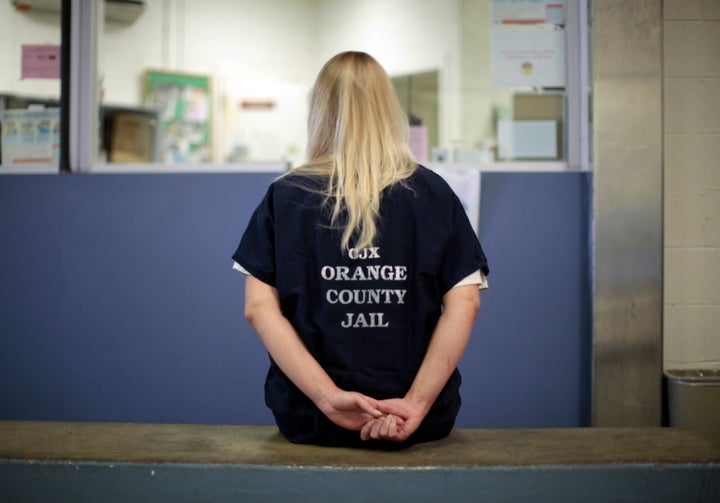
The Me Too movement has successfully taken down some powerful men who sexually abuse and harass women. But a large group of survivors has been excluded from the conversation: incarcerated women.
Women in prisons and jails face rampant sexual abuse at the hands of correctional officers. If you go into a prison and ask, “Who has been a victim of sexual harassment or assault?” I’m certain everyone will raise their hand. Rape is a part of prison culture, and our voices have been silenced for too long. Me Too must include us, too.
Incarcerated women have their rights stripped from them, including the right to consent or object to sex. Sexual contact of any kind with an incarcerated person is illegal. But when I got to prison, it didn’t take long for me to experience unwanted sexual advances from male correctional officers. It is a normal part of daily prison life for officers to abuse their power and harass the women they are supposed to monitor. Often, unwanted attention turns into sexual assault. Often, they rape us. And we are forced to stay silent.
Being confined in a facility where our abusers work every day is torture. This is something I experienced firsthand, time and again, during my 17-year sentence.
Sergeant P. asked me to sleep naked for him. I refused. The next morning he entered my cell and woke me up by roughly grabbing my breasts saying, “You didn’t do what I asked.” He woke me up every morning after that ― sometimes with sexual advances and sometimes just to intimidate me. When he looked at me, I felt violated, as if bugs were crawling all over my body. And he knew there was nothing I could do about it.
Officer B. explicitly told me whenever we were alone how he would “fuck” me, and his harassment didn’t stop there. Once, while I was discarding food into a loud, giant compacter behind the mess hall, Officer B. came up behind me. He yanked down my pants and tried to penetrate me as my screams were drowned out by the loud compactor. He only stopped when the machine turned off.
“Incarcerated women cannot escape their abusers, and they place themselves at risk of retaliation if they speak up.”
Officer S. roughly grabbed my breasts and nipples while patting me down and frisking me. He ran his hands down my body and cupped and squeezed my vagina.
Officer R. raped me, and I was reminded of this every day, as the window of my housing unit looked out onto the building where the assault took place.
This daily humiliation and violence were all too familiar. My boyfriend also raped me. He acted like I was his property, and if I didn’t give my body to him, he took it. When I became state property, the officers treated me the same way ― and I am not alone in this reality.
Over 85 percent of incarcerated women have experienced sexual violence in their lifetimes ― and the abuse is repeated behind prison walls. Women in prison are disproportionately women of color, and the vast majority are economically marginalized.
Incarcerated women cannot escape their abusers, and they place themselves at risk of retaliation if they speak up. When an incarcerated woman does come forward about sexual abuse, the prison’s response is often to transfer her out of the facility ― not the officer. This system effectively keeps the men who commit such violence inside, and brands the victims who speak up as “troublemakers” and “snitches.” Most incarcerated women want to avoid transferring facilities because this could jeopardize their minimal access to family visits.
I was one of those women. I am from Rochester, so being in upstate New York meant my family could regularly visit me. I had previously been incarcerated downstate, during which time I saw my family just once in four years. I couldn’t go that long without seeing them again, so I kept silent about the abuse I was experiencing.
Halfway through my sentence, I got tired of the lack of recourse. So, when I caught an officer having sex with a woman in the officer’s bathroom, I risked retaliation and made an official complaint to the inspector general. When the head of the IG sex crimes unit came to see me, she said she could do nothing unless I brought her physical evidence. Stunned, I asked if that meant in effect I had to engage in a sex act with the officer to gather this evidence. She replied, “Or however you can get it.” No further action was taken, and the woman was transferred downstate. Nothing changed.
Today, I am no longer afraid to speak out. The power of Me Too made me think: Why not us, too? Even though we broke the law, rape, intimidation and sexual harassment were not part of our sentence. I want to say to the officers: Your job was to maintain “care, custody and control,” not to rape or harass me.
The core values of prison culture ― punishment and control ― give rise to abuse. Lawmakers should seek alternatives to incarceration that create real opportunities for people to both take responsibility for the harm they have caused and also heal from the trauma they have experienced.
Here in New York, activists are campaigning to pass the Domestic Violence Survivors Justice Act, which would give judges the discretion to direct abuse survivors to alternative programs when they are convicted of crimes directly related to abuse. Activists in other states should follow suit.
“Even though we broke the law, rape, intimidation and sexual harassment were not part of our sentence.”
Everyday citizens may not think mass incarceration affects them, but it affects every one of us, right down to our tax dollars. Each American can, and should, take the time to listen to formerly incarcerated women and men, and learn about what happens every day behind prison walls.
Prisons are ultimately money-making institutions that re-victimize people who have experienced trauma in the name of keeping society safe. Once we recognize that, we must question our belief in a system that fails us all, over and over again.
Through my partnership with the Women & Justice Project, I am part of a large community of formerly incarcerated women who are helping to guide the transformation of Manhattan’s Bayview Correctional Facility. The former women’s prison once had the highest rate of reported staff sexual abuse. We are now transforming it into The Women’s Building, a global hub for girls’ and women’s rights movements. A critical step in this process is to acknowledge the building’s history as a space of both dehumanization and women’s resilience and to recognize the potential to transform other women’s prisons around the country.
However, incarcerated women need a voice while they’re still inside those walls. For the Me Too movement to have a meaningful impact on ending rape culture, it must include the voices of incarcerated women, who, at this very moment, are still silently enduring horrific abuse.
Kim Brown is an anti-domestic violence and criminal justice reform activist, who served 17 years in prison for defending herself from her abuser.
